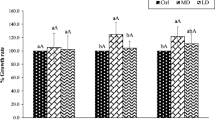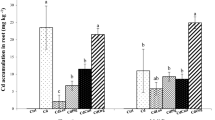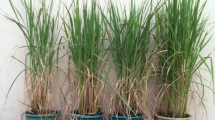Abstract
Cadmium (Cd) stress is a serious concern in agricultural soils worldwide, and increasing accumulation and subsequent transfer to humans via the food chain can have potentially harmful effects. In this study, field experiments were conducted to examine the uptake and translocation of Cd in rice, changes in the soil Cd speciation, and the subsequent effect on Cd accumulation in rice under combined organic (farmyard manure and crop straw) and inorganic (sepiolite, lime, and calcium-magnesium phosphate) soil amendments. The results showed that farmyard manure combined with sepiolite or lime and straw combined with lime or calcium-magnesium phosphate reduced the Cd translocation from the rice roots to the straw and the grains, significantly decreasing the Cd accumulation in brown rice. In addition, straw combined with sepiolite, lime, or calcium-magnesium phosphate reduced the Cd accumulation in brown rice but increased the Cd translocation from the roots to the straw by 37.8–279.3% compared with the control. Organic-inorganic amendments also decreased the soil exchangeable Cd and increased the organic-bound Cd by more than 40%. Fe-Mn oxide-bound Cd also increased but varied with growth. Cd accumulation in brown rice showed a significant positive relationship with soil exchangeable Cd at 90 days after transplantation, while at 30 days, the increase in Fe-Mn oxide- and organic-bound Cd was found to be the key factor in reducing the Cd accumulation in rice. These findings suggest that straw (under rice-rape rotation) and farmyard manure (under rice-wheat rotation) combined with sepiolite or lime are widely applicable as agronomic control techniques aimed at lowering Cd pollution.





Similar content being viewed by others
References
Ali B, Qian P, Jin R, Ali S, Khan M, Aziz R, Tian T, Zhou W (2014) Physiological and ultrastructural changes in Brassica napus seedlings induced by cadmium stress. Biol Plant 58:131–138
FAO 2014 ProdStat. Core Production Data Base, Electronic resource under http://faostat.fao.org
Gallego SM, Pena LB, Barcia RA, Azpilicueta CE, Iannone MF, Rosales EP, Benavides MP (2012) Unravelling cadmium toxicity and tolerance in plants: insight into regulatory mechanisms. Environ Exp Bot 83:33–46
Gunawardana B, Singhal N, Johnson A (2010) Amendments and their combined application for enhanced copper, cadmium, lead uptake by Loliumperenne. Plant Soil 329(1–2):283–294
Jiang H, Li T, Han X, Yang X, He Z (2012) Effects of pH and low molecular weight organic acids on competitive adsorption and desorption of cadmium and lead in paddy soils. Environ Monit Assess 184(10):6325–6335
Juang KW, Ho PC, Yu CH (2012) Short-term effects of compost amendment on the fractionation of cadmium in soil and cadmium accumulation in rice plants. Environ Sci Pollut R 19(5):1696–1708
Khan MA, Khan S, Khan A, Alam M (2017) Soil contamination with cadmium, consequences and remediation using organic amendments. Sci Total Environ 601(602):1591–1605
Kim SC, Yang JE, Ok YS, Skousen J, Kim DG, Joo JH (2010) Accelerated metolachlor degradation in soil by zerovalent iron and compost amendments. Bull Environ Cotam Toxicol 84(4):459–464
Kögel-Knabner I, Amelung W, Cao Z, Fiedler S, Frenzel P, Jahn R, Kalbitz K, Kölbl A, Schloter M (2010) Biogeochemistry of paddy soils. Geoderma 157(1):1–14
Lee SS, Lim JE, El-Azeem SAMA, Choi B, Oh SE, Moon DH, Ok YS (2013) Heavy metal immobilization in soil near abandoned mines using eggshell waste and rapeseed residue. Environ Sci Pollut R 20(3):1719–1726
Li B, Wang CQ, Dai TF, Li HX, Yang J (2007) Accumulation of heavy metals in rice seeds as influenced by metal speciation and soil properties. Plant Nutrition and Fertilizer Science 13(4):602–610
Li B, Wang CQ, Yang J, Tan T, Li HX, Li QQ, Yuan Q (2009) Regional distribution and pollution evaluation of heavy metals in top soils of the Chengdu plain. Acta Agric Nucleatae Sin 23(2):308–315
Liang X, Han J, Xu Y, Sun Y, Wang L, Tan X (2014) In situ field-scale remediation of Cd polluted paddy soil using sepiolite and palygorskite. Geoderma 235:9–18
Liu S, Huang D, Chen A, Wei W, Brookes PC, Li Y, Wu J (2014) Differential responses of crop yields and soil organic carbon stock to fertilization and rice straw incorporation in three cropping systems in the subtropics. Agric Ecosyst Environ 184:51–58
Lu RK (2000) Analysis method of soil agro-chemistry China agricultural science and technology press. Beijing 12-13(106–107):146–226
Madejón E, DeMora AP, Felipe E, Burgos P, Cabrera F (2006) Soil amendments reduce trace element solubility in a contaminated soil and allow regrowth of natural vegetation. Environ Pollut 139(1):40–52
Ministry of Environmental Protection, PRC (1995) National Committee of standardization. In: Environmental quality standard for soils (GB15618–1995). Standards Press of China, Beijing
Ministry of Health, PRC (2012) National Committee of Standardization. The Maximum Levels of Contaminants in Foods (GB2762–2012). Standards Press of China, Beijing
Mohamed I, Ahamadou B, Li M, Gong C, Cai P, Liang W, Huang Q (2010) Fractionation of copper and cadmium and their binding with soil organic matter in a contaminated soil amended with organic materials. J Soils Sediments 10(6):973–982
Ok YS, Usman AR, Lee SS, El-Azeem SAA, Choi B, Hashimoto Y, Yang JE (2011) Effects of rapeseed residue on lead and cadmium availability and uptake by rice plants in heavy metal contaminated paddy soil. Chemosphere 85:677–682
Pan Y, Zhou LX (2007) Influence of applying organic manures on the chemical form of Cu and Cd in the contaminated soil and on wheat uptake: field micro-plot trials. Journal of Nanjing Agricultrual University 30(2):142–146
Park JH, Lamb D, Paneerselvam P, Choppala G, Bolan N, Chung JW (2011) Role of organic amendments on enhanced bioremediation of heavy metal(loid) contaminated soils. J Hazard Mater 185(2):549–574
Putwattana N, Kruatrachue M, Kumsopa A, Pokethitiyook P (2015) Evaluation of organic and inorganic amendments on maize growth and uptake of Cd and Zn from contaminated paddy soils. Int J Phytoremediation 17(2):165–174
Qayyum MF, Rehman MZ, Ali S, Rizwan M, Naeem A, Maqsood MA, Khalid H, Rinklebe J, Ok YS (2017) Residual effects of monoammonium phosphate, gypsum and elemental sulfur on cadmium phytoavailability and translocation from soil to wheat in an effluent irrigated field. Chemosphere 174:515–523
Ran J, Wang D, Wang C, Zhang G, Zhang H (2016) Heavy metal contents, distribution, and prediction in a regional soil-wheat system. Sci Total Environ 544:422–431
Rehman MZ, Rizwan M, Ali S, Fatima N, Yousaf B, Naeem A, Sabir M, Ahmad HR, Ok YS (2016) Contrasting effects of biochar, compost and farm manure on alleviation of nickel toxicity in maize (Zea mays L.) in relation to plant growth, photosynthesis and metal uptake. Ecotoxicol Environ Saf 133:218–225
Rehman MZ, Khalid H, Akmal F, Ali S, Rizwan M, Qayyum MF, Iqbal M, Khalid MU, Azhar M (2017) Effect of limestone, lignite and biochar applied alone and combined on cadmium uptake in wheat and rice under rotation in an effluent irrigated field. Environ Pollut 227:560–568
Rizwan M, Ali S, Adrees M, Rizvi H, Rehman MZ, Hannan F, Qayyum MF, Hafeez F, Ok YS (2016a) Cadmium stress in rice: toxic effects, tolerance mechanisms and management: a critical review. Environ Sci Pollut R 23:17859–17879
Rizwan M, Ali S, Abbas T, Rehman MZ, Hannan F, Keller C, Al-Wabel MI, Ok YS (2016b) Cadmium minimization in wheat: a critical review. Ecotoxicol Environ Saf 130:43–53
Rizwan M, Ali S, Qayyum MF, Ibrahim M, Rehman MZ, Abbas T, Ok YS (2016c) Mechanisms of biochar-mediated alleviation of toxicity of trace elements in plants: a critical review. Environ Sci Pollut R 23:2230–2248
Sabir M, Ali A, Rehman MZ, Hakeem KR (2015) Contrasting effects of farmyard manure (FYM) and compost for remediation of metal contaminated soil. Int J Phytorem 17:613–621
Sato A, Takeda H, Oyanagi W, Nishihara E, Murakami M (2010) Reduction of cadmium uptake in spinach (Spinaciaoleracea L.) by soil amendment with animal waste compost. J Hazard Mater 181(1):298–304
Sebastian A, Prasad MNV (2014) Cadmium minimization in rice—a review. Agron Sustain Dev 34(1):155–173
Shaheen SM, Rinklebe J (2015) Impact of emerging and low cost alternative amendments on the (im) mobilization and phytoavailability of Cd and Pb in a contaminated floodplain soil. Ecol Eng 74:319–326
Su DC, Jiao WP, Zhou M, Chen X (2010) Can cadmium uptake by Chinese Cabbage be reduced after growing Cd-accumulating rapeseed? Pedosphere 20(1):90–95
Tang X, Li X, Liu X, Hashmi MZ, Xu J, Brookes PC (2015) Effects of inorganic and organic amendments on the uptake of lead and trace elements by Brassica chinensis grown in an acidic red soil. Chemosphere 119:177–183
Tessier A, Campbell PG, Bisson M (1979) Sequential extraction procedure for the speciation of particulate trace metals. Anal Chem 51(7):844–851
Wang F, Ouyang W, Hao F, Lin C, Song N (2014) In situ remediation of cadmium-polluted soil reusing four by-products individually and in combination. J Soils Sediments 14(3):451–461
Xiao SS, Li LQ, Pan GX, Jiao SJ, Gong WQ (2006) Effect of submerging and wetting-redrying on Cd speciation and uptake by sorghum hybrid sudangrass in two paddy soils under spiked Cd. Environ Sci 27(2):351–355
Ye XX, Li HY, Zhang LG, Chai RS, Tu RF, Gao HJ (2018) Amendment damages the function of continuous flooding in decreasing Cd and Pb uptake by rice in acid paddy soil. Ecotoxicol Environ Saf 147:708–714
Yu H, Wang J, Fang W, Yuan J, Yang Z (2006) Cadmium accumulation in different rice cultivars and screening for pollution-safe cultivars of rice. Sci Total Environ 370(2):302–309
Zhou H, Zhou X, Zeng M, Liao BH, Liu L, Yang WT, Wu YM, Qiu QY, Wang YJ (2014) Effects of combined amendments on heavy metal accumulation in rice (Oryza sativa L.) planted on contaminated paddy soil. Ecotoxicol Environ Saf 101:226–232
Acknowledgments
The authors thank Sichuan Agricultural University and the Jinyang Agricultural Bureau of Sichuan Province for providing the research facility and field experiment station. We are grateful to the National Key Research and Development Program of China (2017YFD0301701) and the Science and Technology Support Plan of Sichuan Province (2017SZ0188) for their support. We would like to thank all those who helped in the preparation of this paper.
Author information
Authors and Affiliations
Corresponding author
Additional information
Responsible editor: Elena Maestri
Rights and permissions
About this article
Cite this article
Li, B., Yang, L., Wang, C.Q. et al. Effects of organic-inorganic amendments on the cadmium fraction in soil and its accumulation in rice (Oryza sativa L.). Environ Sci Pollut Res 26, 13762–13772 (2019). https://doi.org/10.1007/s11356-018-2914-1
Received:
Accepted:
Published:
Issue Date:
DOI: https://doi.org/10.1007/s11356-018-2914-1




